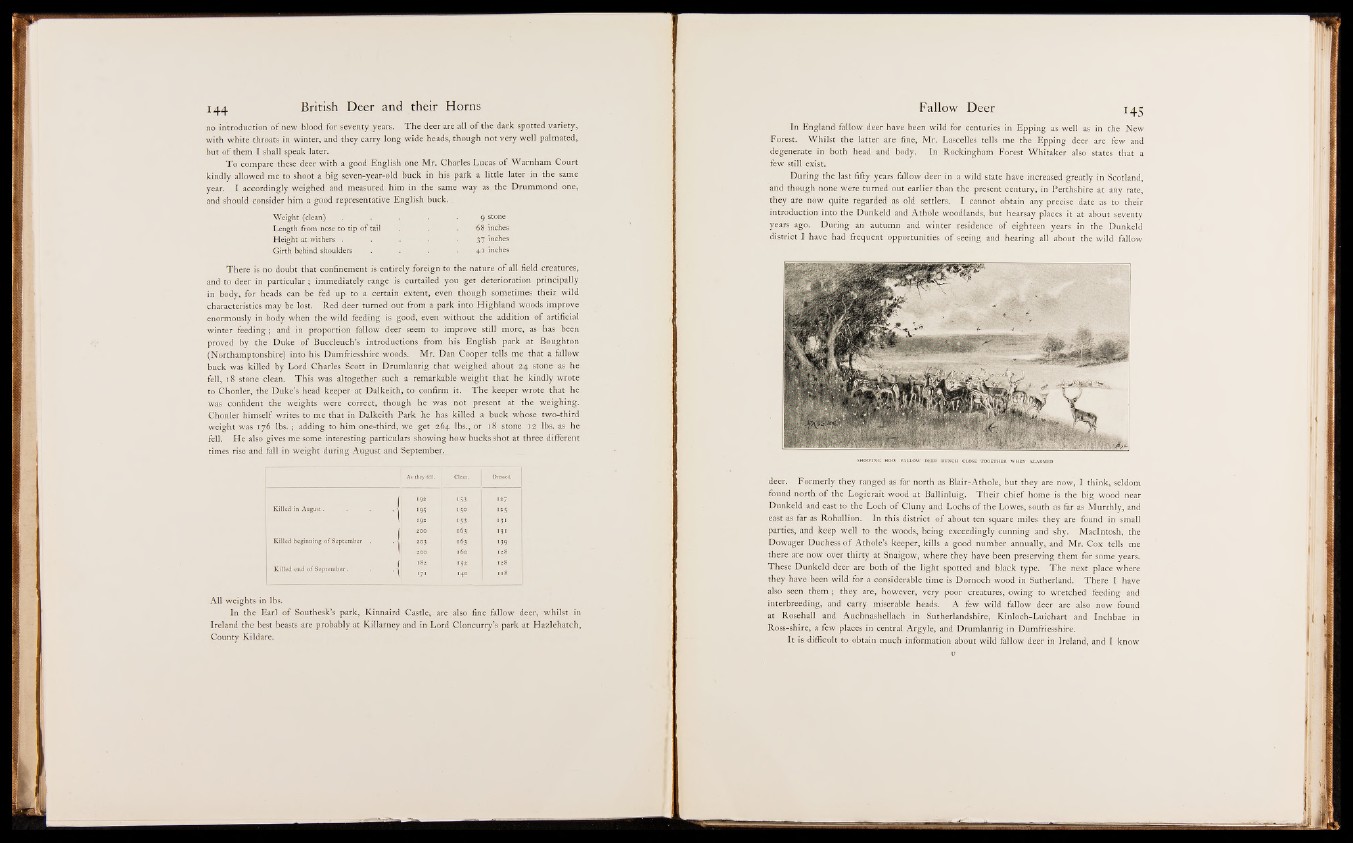
no introduction o f new blood for seventy .years. The deer are all o f the dark spotted variety,
with white throats in winter, and they carry long wide heads, though not very well palmated,
but o f them I shall speak later.
To compare these deer with a good English one Mr. Charles Lucas o f Warnham Court
kindly allowed me to shoot a big seven-year-old buck in his park a little later in the same
year. I accordingly weighed and measured him in the same way as the Drummond one,
and should consider him a good representative English buck.
Weight (clean) . _ . . . - 9 stone
Length from nose to tip of tail . . 68 inches
Height at withers . . . . • 37 inches
Girth behind shoulders . . . . 41 inches
There is no doubt that confinement is entirely foreign to the nature o f all field creatures,
and to deer in particular ; immediately range is curtailed you get deterioration principally
in body, for heads can be fed up to a certain extent, even though sometimes their wild
characteristics may be lost. Red deer turned out from a park into Highland woods improve
enormously in body when the wild feeding is good, even without the addition o f artificial
winter feeding ; and in proportion fallow deer seem to improve still more, as has been
proved by the Duke o f Buccleuch’s introductions from his English park at Boughton
(Northamptonshire) into his Dumfriesshire woods. Mr: Dan Cooper tells me that a fallow
buck was killed by Lord Charles Scott in Drumlanrig that weighed about 24 stone as he
fell, 18 stone clean. This was altogether such a remarkable weight that he kindly wrote
to Chonler, the Duke’s head keeper at Dalkeith, to confirm it. The keeper wrote that he
was confident the weights were correct, though he was not present at the weighing.
Chonler himself writes to me that in Dalkeith Park he has killed a buck whose two-third
weight was 176 lbs. ; adding to him one-third, we get 264 lbs., or 18 stone 12 lbs. as he
fell. He also gives me some interesting particulars showing how bucks shot at three different
times rise and fall in weight during August and September.
As they fell. Clean. Dressed
f 1H1 153 127
Killed in August.
■ l J-92 IS 3 I3I
( 200 163 131
Killed beginning of September . • j 263 163 139
w ' 160 I28
Killed end of September. nf nD 140 I l8
A ll weights in lbs.
In the Earl o f Southesk’s park, Kinnaird Castle, are also fine fallow deer, whilst in
Ireland the best beasts are probably at Killarney and in Lord Cloncurry’s park at Hazlehatch,
County Kildare.
In England fallow deer have been wild for centuries in Epping as well as in the New
Forest. Whilst the latter are fine, Mr. Lascelles tells me the Epping deer are few and
degenerate in both head and body. In Rockingham Forest Whitaker also states that a
few still exist.
During the last fifty years fallow deer in a wild state have increased greatly in Scotland,
and though none were turned out earlier than the present century, in Perthshire at any rate,
they are now quite regarded as old settlers. I cannot obtain any precise date as to their
introduction into the Dunkeld and Athole woodlands, but hearsay places it at about seventy
years ago. During an autumn and winter residence o f eighteen years in the Dunkeld
district I have had frequent opportunities o f seeing and hearing all about the wild fallow
deer. Formerly they ranged as far north as Blair-Athole, but they are now, I think, seldom
found north o f the Logierait wood at Ballinluig. Their ch ief home is the big wood near
Dunkeld and east to the Loch o f Cluny and Lochs o f the Lowes, south as far as Murchly, and
east as far as Rohallion. In this district o f about ten square miles- they are found in small
parties, and keep well to the woods, being exceedingly cunning and shy. Macintosh, the
Dowager Duchess o f Athole’s keeper, kills a good number annually, and Mr. Cox tells me
there are now over thirty at Snaigow, where they have been preserving them for some years.
These Dunkeld deer are both o f the light spotted and black type. The next place where
they have been wild for a considerable time is Dornoch wood in Sutherland. There I have
also seen them ; they are, however, very poor creatures, owing to wretched feeding and
interbreeding, and carry miserable heads. A few wild fallow deer are also now found
at Rosehall and Auchnashellach in Sutherlandshire, Kinloch-Luichart and Inchbae in
Ross-shire, a few places in central Argyle, and Drumlanrig in Dumfriesshire.
It is difficult to obtain much information about wild fallow deer in Ireland, and I know
u